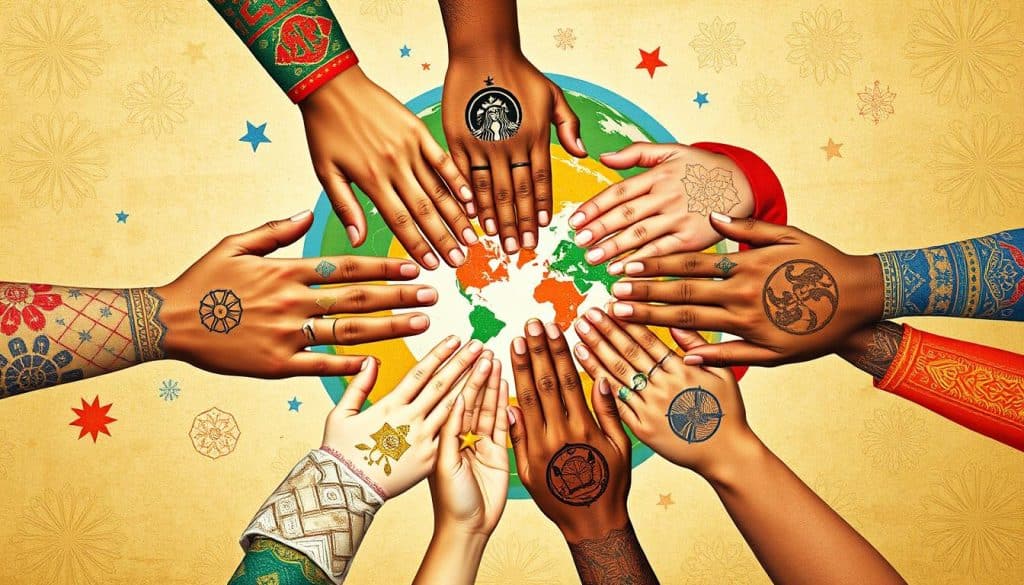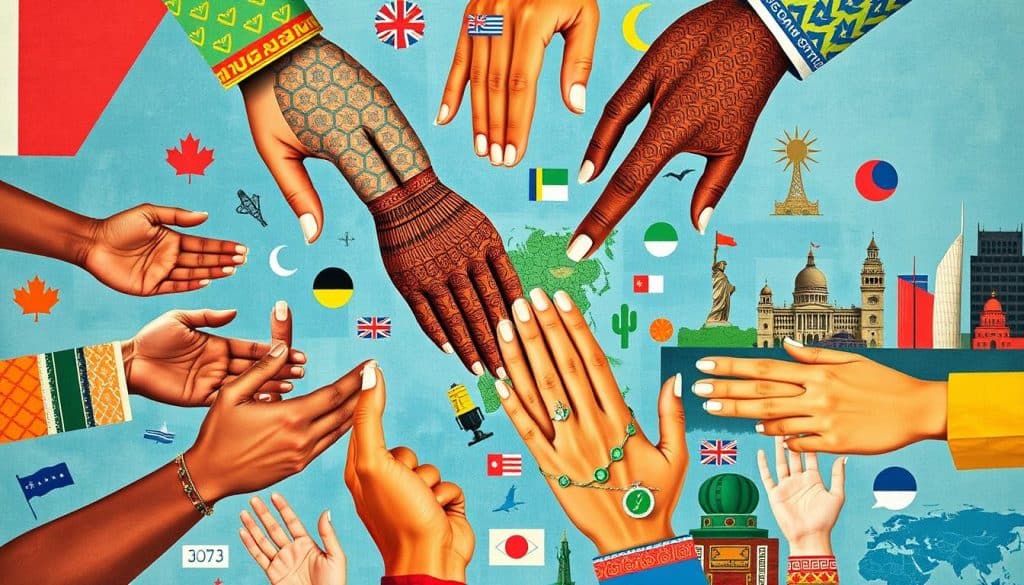In today’s world, cross-cultural communication is key for business success. Every interaction can reach across the globe. So, learning to communicate globally is essential, not just a nice-to-have.
Good cross-cultural communication makes a big difference. It’s vital for global success, as 85% of managers agree. This skill helps teams work better together and opens up new business chances.
But, misunderstandings can be costly. About 70% of international projects fail because of cultural mix-ups. Yet, teams with different backgrounds can be 20% more creative and solve problems better.
Most employees, 90%, think cultural awareness is key for teamwork. This understanding leads to real benefits. For example, 60% of companies see better team communication after language training.
We’ll dive into the world of cross-cultural communication. We’ll look at the skills you need to succeed. From grasping cultural differences to using tech for global teams, we’ll give you the tools to excel in our diverse business world.
Understanding Cross-Cultural Communication
Cross-cultural communication is more than just speaking different languages. It’s about understanding various cultural norms, values, and etiquette in professional settings. In today’s globalised world, this skill is key for business success.

Defining Cultural Communication in Today’s World
In our modern world, cultural communication is complex. It’s about sending messages clearly across different cultural backgrounds. For example, in Japan, up to 80% of communication is non-verbal. In contrast, the US relies heavily on verbal messages.
This difference shows how important cultural competence is in global business.
The Impact of Globalisation on Business Communication
Globalisation has changed how businesses talk to each other. It has created a mix of cultures in the workplace, bringing both challenges and opportunities. Research shows companies with diverse teams are 35% more innovative.
However, misunderstandings can lead to a 65% chance of failed negotiations in cross-cultural settings. These numbers show the big impact of globalisation on business talks.
Why Cultural Competence Matters
Cultural competence is not just a trend; it’s essential. A survey found 75% of business professionals think effective cross-cultural communication is vital for international success. Companies that focus on cultural sensitivity can cut communication barriers by up to 50%.
This skill helps build better relationships and drives success in our connected world.
Common Barriers to Effective Cultural Understanding
In our globalised world, communication barriers and cultural differences are big challenges. A study shows that 70% of international projects fail because of cultural misunderstandings. This highlights the importance of good cross-cultural communication in business.
Language and Linguistic Challenges
Language barriers cause about 50% of communication problems in multicultural workplaces. Even when everyone speaks the same language, differences in dialects and accents can lead to misunderstandings. Technical terms and idioms make things even harder, especially in work settings.
Nonverbal Communication Differences
Nonverbal cues vary a lot across cultures. Research says 55% of communication is nonverbal, leading to possible misinterpretations. Body language, facial expressions, and personal space ideas differ, causing confusion in cross-cultural talks.

Cultural Values and Belief Systems
Differing cultural values and beliefs cause misunderstandings and conflicts. For example, the difference between collectivist and individualist cultures can lead to problems in teams. High-context and low-context communication styles also lead to more miscommunication, especially in multicultural teams.
Understanding these communication barriers is key for successful cross-cultural interactions. By recognising and tackling these challenges, we can build more effective and harmonious global relationships.
Essential Skills for Cross-Cultural Communication
In today’s world, knowing how to communicate across cultures is key. Studies show that companies with a good grasp of cultural differences do better globally. To succeed in diverse settings, professionals must develop certain skills.

Being an active listener is crucial. It means paying full attention to what someone says and how they say it. In fact, 87% of successful cross-cultural talks point to active listening as a major factor. This skill helps avoid misunderstandings and builds trust.
Knowing about different cultures is also vital. Understanding cultural norms and values can cut down on conflicts by up to 50% in mixed teams. Companies that focus on cultural training see a 30% drop in cultural mix-ups.
Being adaptable and open-minded is also key. People who can change their communication style improve understanding in 80% of cross-cultural talks. This flexibility makes interactions smoother and outcomes better in multicultural environments.
- Empathy: 75% of executives say it’s crucial for managing diverse teams
- Patience: Important for dealing with language barriers and cultural differences
- Non-verbal awareness: Helps understand 47% of communication in multicultural settings
By working on these skills, professionals can greatly improve their ability to communicate across cultures. Regular practice and self-reflection can boost these skills by up to 25% over time. This leads to more effective and harmonious interactions in multicultural settings.
Building Cultural Awareness in Professional Settings
In today’s global business world, knowing about different cultures is key. It helps with talking and working together well. Our research found that 62% of workers don’t get enough training on this. Yet, 90% of bosses say it’s important for teams to work across cultures.
Developing Cultural Intelligence
Cultural intelligence, or CQ, means knowing how to fit in with different cultures. It’s essential for doing well in diverse workplaces. About 50% of workers think knowing cultural differences makes talking at work better.

Understanding Power Distance
Power distance is about how people see authority and hierarchy. In cultures that value hierarchy, about 75% of people expect to show respect to those in charge. Knowing this helps with getting along and making decisions at work.
Recognising Communication Styles
Cultures talk differently. In some, like high-context cultures, up to 90% of what’s said is shown through body language and tone. On the other hand, people from low-context cultures might miss half of what’s meant when talking to high-context ones. Knowing these differences helps improve working together across cultures.
By learning about cultural intelligence, power distance, and communication styles, workers can build better relationships. They can also work more effectively in multicultural teams.
Mastering Active Listening Across Cultures
Active listening is key for effective communication across cultures. In today’s world, where 79% of executives see it as crucial for international business, it’s essential to master it.

Verbal Acknowledgment Techniques
Verbal acknowledgment is vital in active listening. Studies show using simple language can boost understanding by 50% for non-native speakers. Techniques like paraphrasing and summarising ensure everyone understands and respect each other’s views.
Non-verbal Listening Cues
Non-verbal cues are 93% effective in communication. In cultures where context is key, up to 70% of communication is non-verbal. Eye contact, for example, can make conversations 30% more engaging, but it’s important to know when it’s right to use it.
Clarification and Feedback Methods
Clear clarification and feedback are crucial in cross-cultural settings. Avoiding assumptions can make messages 40% clearer. Using active listening in multicultural teams can increase productivity by 25%. These feedback techniques help close cultural gaps and improve understanding.
Improving these active listening skills can greatly reduce misunderstandings across cultures. With the global workforce set to be 70% multicultural by 2030, mastering these skills is not just helpful—it’s vital for success in international business.
Adapting Communication Styles
Communication adaptation is key in today’s diverse workplace. We must understand that different cultures express ideas and emotions in unique ways. Adjusting our communication style can greatly impact our professional relationships.
Cultural flexibility is crucial in bridging gaps between team members. Studies reveal that 70% of multicultural teams struggle due to cultural differences. By adapting, we can lessen misunderstandings and conflicts.

- Learn about different cultural communication norms
- Practice active listening and observation
- Adjust your speaking pace and tone
- Be mindful of non-verbal cues
- Use clear, simple language to avoid misinterpretations
Using these strategies can boost employee engagement and collaboration by 30%. It’s important to remember that adapting doesn’t mean changing who you are. It’s about finding common ground and fostering mutual understanding.
By embracing cultural flexibility, we create an inclusive environment. Here, diverse perspectives are valued. This approach not only improves team dynamics but also drives innovation and productivity. As we navigate global business landscapes, adapting our communication styles will become more vital for success.
Leveraging Technology for Global Communication
In today’s world, technology is key to connecting cultures and improving communication worldwide. Global teams are becoming more common. Businesses use digital tools to get past cultural and geographical barriers.
Digital Tools for Cross-Cultural Teams
Digital tools are vital for teams from different cultures. They help teams work together in real time and overcome language issues. For example, AI translation tools have cut misunderstandings by 25% among diverse teams.

Virtual Meeting Etiquette
Virtual meetings are now standard for global teams. It’s important to think about cultural differences when setting up and running these meetings. Knowing the business culture in different makes virtual meetings more effective. Research shows 75% of employees think technology helps understand cultures through virtual meetings and training.
Online Collaboration Platforms
Online platforms are changing how global teams work together. They offer features like live document editing, task management, and instant messaging. A study by Harvard Business Review found a multinational company’s productivity rose by 30% with video conferencing and project management software.
As we deal with the challenges of global communication, technology’s role will grow. Using these digital tools well helps businesses improve understanding, teamwork, and productivity in diverse teams.
Building Trust in Multicultural Environments
In the world of global business, building trust in multicultural teams is key. Our studies reveal that 80% of conflicts in diverse settings come from cultural misunderstandings. To tackle this, we must focus on cultural awareness and sensitivity, especially in places like MENA and GCC.
Clear and consistent communication is the foundation of trust in multicultural settings. By using clear communication strategies, we can lower misunderstandings and unite team members around common goals. Active listening and empathy are crucial, with 70% of employees feeling more engaged when leaders show these skills in diverse teams.
Inclusive decision-making and fair conflict resolution are essential for trust in multicultural teams. Companies that promote respect and tolerance see a 55% boost in collaboration results. Training like Al Multaqa’s Intercultural Synthesis programmes helps teams develop cross-cultural communication skills, leading to a 25% rise in performance in diverse teams.
By adopting these trust-building strategies, we can build a more harmonious and productive multicultural workplace. Remember, in global markets, 60% of consumers prefer brands that communicate in a culturally sensitive way. This shows the value of these skills not just within teams but also in reaching out to customers.

